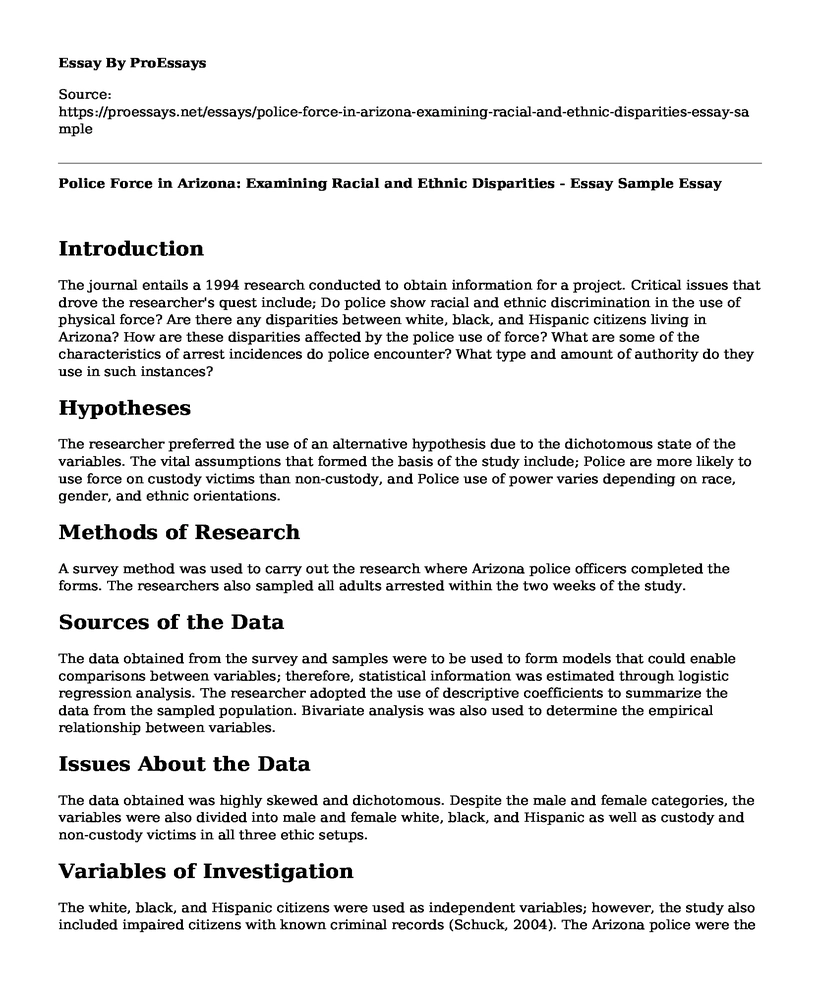Introduction
The journal entails a 1994 research conducted to obtain information for a project. Critical issues that drove the researcher's quest include; Do police show racial and ethnic discrimination in the use of physical force? Are there any disparities between white, black, and Hispanic citizens living in Arizona? How are these disparities affected by the police use of force? What are some of the characteristics of arrest incidences do police encounter? What type and amount of authority do they use in such instances?
Hypotheses
The researcher preferred the use of an alternative hypothesis due to the dichotomous state of the variables. The vital assumptions that formed the basis of the study include; Police are more likely to use force on custody victims than non-custody, and Police use of power varies depending on race, gender, and ethnic orientations.
Methods of Research
A survey method was used to carry out the research where Arizona police officers completed the forms. The researchers also sampled all adults arrested within the two weeks of the study.
Sources of the Data
The data obtained from the survey and samples were to be used to form models that could enable comparisons between variables; therefore, statistical information was estimated through logistic regression analysis. The researcher adopted the use of descriptive coefficients to summarize the data from the sampled population. Bivariate analysis was also used to determine the empirical relationship between variables.
Issues About the Data
The data obtained was highly skewed and dichotomous. Despite the male and female categories, the variables were also divided into male and female white, black, and Hispanic as well as custody and non-custody victims in all three ethic setups.
Variables of Investigation
The white, black, and Hispanic citizens were used as independent variables; however, the study also included impaired citizens with known criminal records (Schuck, 2004). The Arizona police were the dependent variables who acted as a representative of the criminal justice system. The researchers also incorporated different fixed control variables such as gender, custody status, race, and ethnicity to identify transparent relationships between the dependent and independent variables.
Report on the Results
The results were estimated in percentages to give clear comparisons of the intensity levels of force used by police on ethnicity, gender, race, and custody status (Schuck, 2004). The results were tabulated in different tables and revealed that racial and ethnic disparities mainly affected the male gender.
Report Findings
The police were found to use force more often on black in custody than on non-custody (Schuck, 2004). The non-custody blacks were more likely to experience police force than both whites and Hispanic. Hispanic citizens also experienced police force more often than whites; however, the blacks were the most affected. In the entire research sample, females were least affected by police brutality.
Supported Hypotheses
The study discovered that racial and ethnic disparity attributed to police use of physical force, which was in line with the researcher's hypothesis. Males victims were the most affected, hence a proof of gender attribution to police brutality.
The Implication of These Findings
The study revealed that the police use of force varied significantly with gender and custody status; nonetheless, this force is attributed to several factors such as impairments, citizen resistance, number of suspects, and other issues (Schuck, 2004). The findings determine police accountability in making ethical decisions within the community.
The Implication of These Findings
For a more prosperous future research, more critical theoretical distinctions should not be ignored since it oversimplifies the study on racial and ethnic disparity. More liberal alpha levels could be applied to disentangle interaction effects and derive a more reliable outcome.
Public Policy in the Area
The public policy portfolio is diverse, and such a study is unlikely to detect complex interactions since police use of force is rare (Schuck, 2004). Factors such as precision of estimates, effect size, and sample size affect the statistical significance of the data; therefore, a more reliable method could be applied.
Limitation of the Study
The respondents were the Arizona police officers, who are part of the criminal justice system. The information provided could, therefore, have been biased since they could fail to provide abusive behavior of their part. The study did not involve the public in question but focused on a police-citizen single encounter; therefore, the information could be termed as unreliable. The study was conducted in two weeks and in a sole jurisdiction hence simple research, which was not adequate in understanding the entire criminal justice system.
Reference
Schuck, A. M. (2004). The masking of racial and ethnic disparity in police use of physical force: The effects of gender and custody status. Journal of Criminal Justice, 32(6), 557-564.
Cite this page
Police Force in Arizona: Examining Racial and Ethnic Disparities - Essay Sample. (2023, Apr 28). Retrieved from https://proessays.net/essays/police-force-in-arizona-examining-racial-and-ethnic-disparities-essay-sample
If you are the original author of this essay and no longer wish to have it published on the ProEssays website, please click below to request its removal:
- Sociology Essay Example: Religious Discrimination in the Workplace
- Legal, Institutional, and Social "Laws" of Gender Essay
- Essay Sample on Educational Stratification for Mexican Americans
- Stop Wearing and Buying Fur Clothes Essay Example
- Essay Example on DHS Established: Securing US Nation After 9/11 Attacks
- Breaking the Cycle of Poverty through Higher Education: My Academic Pursuit - Essay Sample
- Essay Example on Completing the Revolution







